The Dennis Lance with Aldershot & District
The Dennis Lance with Aldershot & District
After seeing the posting by Ian Thompson of the Aldershot & District Dennis Lance GOU 845 I thought the following maybe of interest.
The original Dennis Lance came on to the market in 1930, and was quickly superseded by the slightly longer Lance II. Two completely different radiator styles were offered, a neat version with a modest bonnet height, and the oval shaped variety as used in the Lancet, with the bonnet set at a ridiculously high level.
www.busmuseum.org.uk/webnews/news035.htm
www.alangeorge.co.uk/Images
www.dennissociety.org.uk/
The Dennis Lance K3 was closely related to the pre war Lance, but employed the advanced O6 power unit of 7.58 litres, exactly the same capacity as that of the well known AEC 7.7. The Dennis engine, however, had four valves per cylinder and no other British manufacturer ever made a four valve engine in quantity. The engine also had wet liners which gave no trouble whatsoever, in marked contrast to Southall's forays into this field. The efficient gas flow properties of the four valve head, together with the high standard of engineering and balancing of components resulted in the O6 engine being possibly the smoothest running diesel of all time. Unlike the ambitious claims of some other makers, the O6 developed a genuine 100 bhp at 1800 rpm, which, when coupled with the 'O' type overdrive gearbox, gave the K3 Lance a sprightly performance. By comparison, the contemporary AEC 7.7 was claimed to give 'up to' 98 bhp at 1800 rpm, and the 6LW delivered a consistent 102 bhp at 1700 rpm. A plate inside the cab of the Aldershot and District Lance K3s instructed drivers not to engage fifth gear below 30 mph - this at a time when 30 mph was the legal maximum speed for a psv. The Lance K3 inherited several features from its pre war namesake, notably the lofty driving position dictated by the earlier absurdly high 'oval' radiator and bonnet, but the radiator for the post war double decker became a smart new design set at a lower level. Strangely, this modern radiator style was not employed on any other Dennis models, though the Lancet would definitely have benefited had it been so adopted. Sadly, in the post war world of Leyland PD2s and AEC Regent IIIs, the Lance appeared to lack the 'unique selling points' of its powerful higher profile competitors. Apart from Aldershot & District and East Kent, major operators seemed to be wary of the four valve cylinder head of the O6, though a great many Independents ran O6 engined Lancets without any trouble at all. In 1947/49 Lancashire United bought 19 Lances with Gardner 6LW engines, and these were classified K2. A total of 49 K3 Lances was built, of which Aldershot & District took 40, and 5 went to Merthyr Tydfil Corporation. Tudor Williams of Laugharne, Carmarthenshire, Ebsworth Bros, also of Laugharne, and Red Rover of Aylesbury all took one each. One 1947 example was bodied as a single deck Santus C33F coach for L.F.Bowen's "Superior" fleet in Birmingham. The appearance was such that it is surprising that Dennis did not offer the Lance style of radiator on the Lancet model.
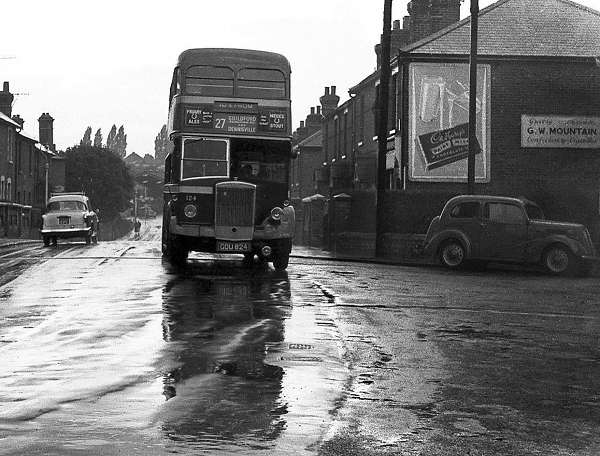
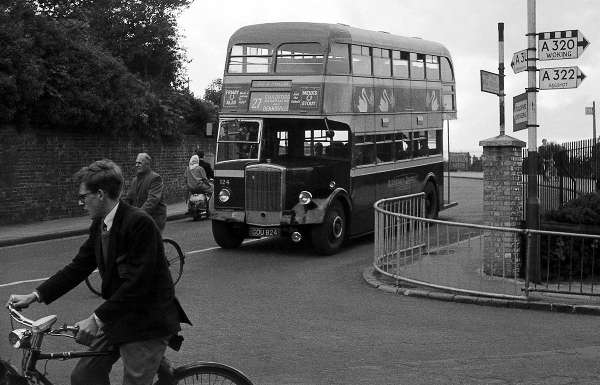
Aldershot & District No.124, GOU 824, the very first K3 delivered to Aldershot & District (in 1948) is seen on a wet day in Guildford Park Road, and again in more clement conditions turning from Farnham Road towards Guildford town centre. Both photos were taken in 1961. Aldershot & District withdrew the K3 fleet the following year as the Loline IIIs arrived. This bus, 124 (originally D729, a number shared, in error with a Lancet J3) spent its entire life working the short local route 27 between Guildford town centre and Dennisville, the estate built by the Dennis company in 1933 to house the White and Poppe workers when engine production was moved from Coventry to Guildford. Dennis had bought White and Poppe in 1919, and after the move, the Coventry factory was sold to Triumph cars.
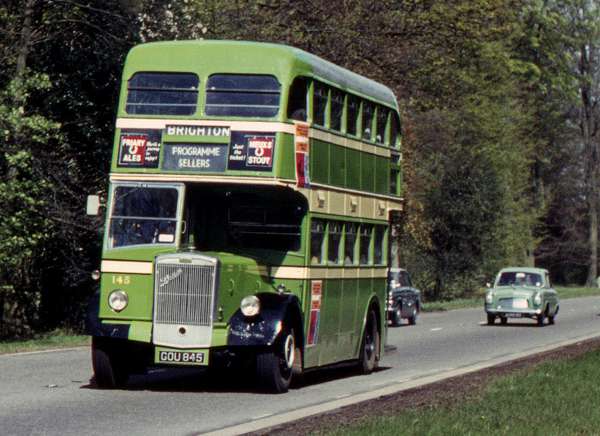
The preserved Lance K3, 145, GOU 845 is pictured on the A23 during a Brighton HCVC run in 1969.
The K4 version of the Lance appeared in 1954 to take advantage of the increase in the permitted length of double deckers to 27 feet. This model was exclusive to Aldershot and District who took 32, 20 of them with East Lancs bodywork and the balance of 12 with a less austere version of the Weymann Orion design. The five speed gearbox was retained, but the power unit became the Gardner 5LW. The engines were recycled from some withdrawn 1939/40 vintage Lancets, but rebuilt and updated to the then latest 'K' specification to give 94 bhp rather than 85 bhp. These buses were equipped with a Dennis variety of the 'Birmingham tin front'.
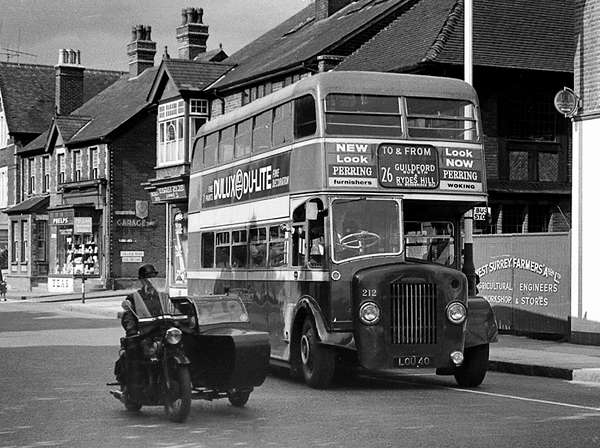
This picture of East Lancs bodied K4 No.212, LOU 40, has appeared on OBP before, but it is included here again to afford comparison.
One final point is worth mentioning about the Aldershot & District vehicle allocation system. Each vehicle running was permanently given to a specific bus, so that the same bus did exactly the same road run every single Weekday/Saturday/Sunday of its entire life, apart from occasional changes for engineering/overhaul reasons. This meant that some buses got hammered day after day on local town work, while others on the trunk routes, like the Farnham - Hogs Back - Guildford run, scarcely suffered any wear and tear at all. So permanent was this arrangement that the garage runout board was actually (beautifully) signwritten with the vehicle fleet numbers against the individual garage departure times. To cope with engineering substitutions, a small pool of spare buses existed, and another board alongside with chalk entries said, "For bus number xxx substitute yyy". I know that this curious arrangement was not unique to Aldershot & District, but it must have been pretty rare, and rightly so. It was daft.
Roger Cox
21/07/14 - 11:11
Over rigid and seemingly daft indeed Roger - its a wonder that reserved seats and "season tickets" weren't allocated to regular commuters !! Having said that though I do think that A & D was a most individual and appealing operator or real character with a glorious livery, and transport history and fascination would have been much the poorer without them.
Chris Youhill
22/07/14 - 06:56
A very interesting and timely potted history of the Dennis Lance, Roger, much appreciated. The links show that some Lances had what I always considered to be the coach rad, but very sloping!
The return journey from Onslow Road Bus Station to Dennisville (route 27) is about 2 miles and the bus station to Rydes Hill, return, about five. Conversely, the return route to Petersfield is about 52 miles, with a third from Guildford through Godalming and Milford being a bit built up, but virtually open road from then on. The first two routes were of 20 minute frequency and the last one hourly. As Chris Y intimated, the system was quaint, but illogical!
For 18 months, in the early 1960's, I used to work only a five minute walk from the bus station and spent many a lunchtime halfhour watching the activity there, that is if I wasn't enjoying a swift pint of Friary Meux beer!
Chris Hebbron
22/07/14 - 06:57
An excellent piece by Roger. I couldn't agree more regarding Roger's comment on vehicle utilisation. Interesting how, even in the contemporary photo, the exposed radiator vehicles look better than the tin front version. As an aside, I visited my cousin in Toronto in 1992 when he was in charge of one of GO Transit's depots. We were talking about the UK bus industry and he was surprised at the growth of Dennis in the UK industry, concentrating as he was on US and Canadian built single deck vehicles. His only knowledge of Dennis buses was the Lolines of North Western from his youth.
I visited his HQ building and depot in 2009 when he was Director of Bus Operations. He was pleased to show me his latest acquisitions, which he had been to Scotland to buy- ADL Enviro 500s 80 seat double deckers. Now as Vice President of GO Operations, his bus division has 117 of these - a quarter of the total bus fleet and a major turnaround for the company, indicative of just how the fortunes of Dennis as a brand has changed since UK bus deregulation.
Phil Blinkhorn
22/07/14 - 08:06
An individual and appealing operator, indeed, Chris, that maintained very high engineering standards until catastrophically subsumed into Thames Valley from 1 February 1972. I cannot claim knowledge of the other depots, but, at Aldershot, there was no bus wash machine. Each evening an army of ladies appeared on the premises armed with long handled brushes, and each bus was washed by hand. The smart paintwork never seemed to grow tired, in marked contrast to that of certain present day fleets. After mercifully escaping from the Halifax Traffic Office, I spent eighteen months as a driver at Aldershot in 1966-68. At A&D, drivers reported to the Chief Engineer, and conductors to the Traffic Manager. The A&D CE was then Colin Clubb, and some years later, when I was a middle manager at LCBS, Reigate, our paths crossed again when he became the GM of London Country. He was a very pleasant man to work for. The A&D livery underwent a change in 1954 when the lower panels of the buses became a darker shade of green, in my opinion enhancing the livery. The preserved Lance K3 is painted in the earlier overall light green with cream relief. I do not have any colour pictures of a Lance in the later livery, but here is a shot of a Loline I.
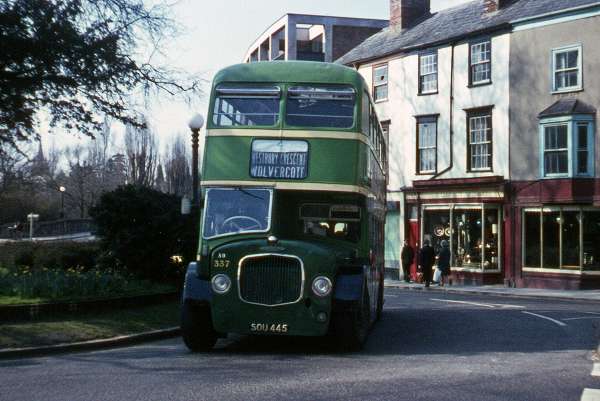
There is a bit of a twist to this picture as it shows East Lancs bodied No.337 SOU 445, working for City of Oxford, another operator with a superb colour scheme. In the early 1970s COMS suffered serious vehicle problems, reputedly owing to difficulties with component supplies from Southall, and Aldershot & District stepped in to help at short notice with some Dennis Lolines, initially Mark IIIs, but these were later substituted by Mark Is. The bus is negotiating the roundabout known as The Plain at the south eastern end of Magdalen Bridge. The scene is scarcely altered some 40 years later; even the architectural excrescence behind the bus is still there, now a Sainsbury Local.
Roger Cox
22/07/14 - 12:58
I entirely agree with RC that the adoption of a darker green on the lower panels enhanced the livery, tremendously I thought. I had no experience of A&D until I lived in Winchester in the early 70's. In a city where all buses were green (bar the odd Wilts and Dorset) the A&D livery on the Loline III's working the #14 was a real head turner. The Tilling liveried Lodekkas on the #47&48 were dull by comparison and the King Alfred fleet was, by then, in very poor shape. I was fortunate to leave before NBC repaints of any of these came along.
I find myself in agreement with Phil Blinkhorn that the exposed radiator on the K3 looks a lot better than the 'tin front' on the K4. This is unusual because in my childhood 'tin fronts' meant modern and tidy and I still hold that uncommon view (I'm probably one of the very few who like the 'St Helen's front). Looking back, the only post war exposed radiator on deckers that looks 'right' is the Titan's and now the Lance (probably because it successfully marries the fluting like a Daimler with shape not unlike like a Leyland). Finally, in Victoria, BC a few years ago and seeking to photo the former New York 'Mancunian' that Gray Line were operating I was pleased and proud to see the six wheel Dennis Enviros that the city had deployed on the University route.
Ortla Nutting
23/07/14 - 06:44
With regard to the amended Aldershot scheme, when North Western and A&D did a Loline swap the A&D Loline was in the revised scheme. Compared to the red and cream shades which predominated in South Manchester and North Cheshire at the time, the Traction Engine, as some crews and enthusiasts came to call it, not only stood out but was beautifully finished inside and out and put the red, hot sprayed and quickly dulled, paint of MCTD to shame.
Orla, Go Transits first use of its ADL Environs was also on University routes.
Phil Blinkhorn
Comments regarding the above are more than welcome please get in touch via the 'Contact Page' or by email at obp-admin@nwframpton.com
All rights to the design and layout of this website are reserved
Old Bus Photos from Saturday 25th April 2009 to Wednesday 3rd January 2024